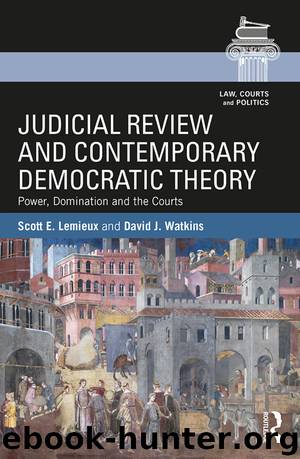Judicial Review and Contemporary Democratic Theory: Power, Domination, and the Courts (Law, Courts and Politics) by Scott E. Lemieux & David J. Watkins

Author:Scott E. Lemieux & David J. Watkins [Lemieux, Scott E.]
Language: eng
Format: azw3
ISBN: 9781138095199
Publisher: Taylor and Francis
Published: 2017-11-02T16:00:00+00:00
Notes
1 This is not to say that the demand that constitutional courts explain themselves has no relevance whatsoever to the question of judicial review’s democratic value. In chapter five, we will argue that this requirement is a point in judicial review’s favor from a democratic perspective, but it is just one small part of the question of judicial review’s democratic valence.
2 Shapiro, “Enough of Deliberation.”
3 Hope Yen, “Roberts Seeks Greater Consensus on Court,” The Washington Post Sunday May 21, 2006. www.washingtonpost.com/wp-dyn/content/article/2006/05/21/AR2006052100678.html (Site last accessed June 8, 2017).
4 Cass R. Sunstein, “The Supreme Court 1995 Term: Foreword: Leaving Things Undecided,” Harvard Law Review 106:6 (1996): 6.
5 Tushnet, The New Constitutional Order, 130.
6 For a summary of some of the liberal law professors who supported Roberts’ confirmation, as well as their reactions after the first full term of the Roberts Court, see Emily Bazelon, “Sorry Now?” Slate June 28, 2007. www.slate.com/id/2169344 (Site last accessed February 16, 2017).
7 Danforth v. Minnesota, 128 USC 1029 (U.S. 2008).
8 Ibid., 878.
9 Keck, The Most Activist Supreme Court in History, 285–293.
10 See Cooper v. Aaron 358 U.S. 1 (U.S. 1958) at 20–23.
11 Bickel, The Least Dangerous Branch.
12 For an analysis of the relationship between Bickel and Sunstein, see Tushnet, “The Jurisprudence of Constitutional Regimes.”
13 Sunstein, One Case at a Time.
14 See Neal Devins, “The Courts: The Democracy-Forcing Constitution,” Michigan Law Review 97:6 (1999): 1971–1993.
15 Sunstein, One Case at a Time, ch. 4.
16 Ibid., 57–60.
17 Ibid., 10–14.
18 Ibid., 19–22.
19 “Bowers was not correct when it was decided, and it is not correct today. It ought not to remain binding precedent. Bowers v. Hardwick should be and now is overruled.” Lawrence v. Texas 539 U.S. 558 (U.S. 1986) at 578.
20 Sunstein also argues in his discussion of Romer v. Evans 517 U.S. 620 (U.S. 1996) that it “would certainly not have been minimalist” to reject “a precedent that is fairly long-standing and that has helped stake out on important position on the meaning and future of the due process clause.” See Sunstein, One Case at a Time, 152.
21 Sunstein, Radicals in Robes, 28–29.
22 The impact of the invalidation of a statute, for example, will depend on such factors as whether the statute is being seriously enforced or whether it can be fairly said to represent a current legislative majority as opposed to a never-repealed legislative majority that is several generations old and whose past legislation is protected by the multiple veto points of Madisonian political institutions, which make it much easier for minorities to block the repeal of old legislation than to get new legislation passed. See Lovell and Lemieux, “Assessing Juristocracy,” 105–109.
23 Sunstein, One Case at a Time, 20.
24 Roe v. Wade 410 U.S. 113 (U.S. 1973).
25 Sunstein, “Concurring.”
26 Our position is that, at least in the context of laws that either lack a strong connection with legitimate state objectives or are arbitrarily enforced, Roe was not excessively broad. Scott Lemieux, “For Richer or Poorer,” The American Prospect January 22, 2007. http://prospect.org/article/richer-or-poorer (Site last accessed May 1, 2017).
27 Harris v.
Download
This site does not store any files on its server. We only index and link to content provided by other sites. Please contact the content providers to delete copyright contents if any and email us, we'll remove relevant links or contents immediately.
Objection! by Nancy Grace(1738)
Apeirogon by Colum McCann(1653)
Anatomy of Injustice by Raymond Bonner(1621)
That Every Man Be Armed by Stephen P. Halbrook(1549)
Civil Procedure (Aspen Casebooks) by Stephen C. Yeazell(1512)
The Vaccine Court by Rohde Wayne(1471)
Injustices by Ian Millhiser(1462)
Storytelling for Lawyers by Meyer Philip(1424)
A Practical Guide to International Arbitration in London by Hilary Heilbron(1396)
Restitution by Restitution(1394)
Coercing Virtue by Robert H. Bork(1322)
Broken Scales by Joel Cohen(1313)
Tangled Webs: How False Statements Are Undermining America: From Martha Stewart to Bernie Madoff by James B. Stewart(1294)
The Tools of Argument: How the Best Lawyers Think, Argue, and Win by Joel Trachtman(1288)
A Matter of Interpretation by Antonin Scalia(1268)
INDEFENSIBLE: One Lawyer's Journey Into the Inferno of American Justice by Feige David(1252)
American Tragedy by Lawrence Schiller & James Willwerth(1246)
A Religious Orgy in Tennessee by H.L. Mencken(1219)
Tangled Webs by James B. Stewart(1212)
